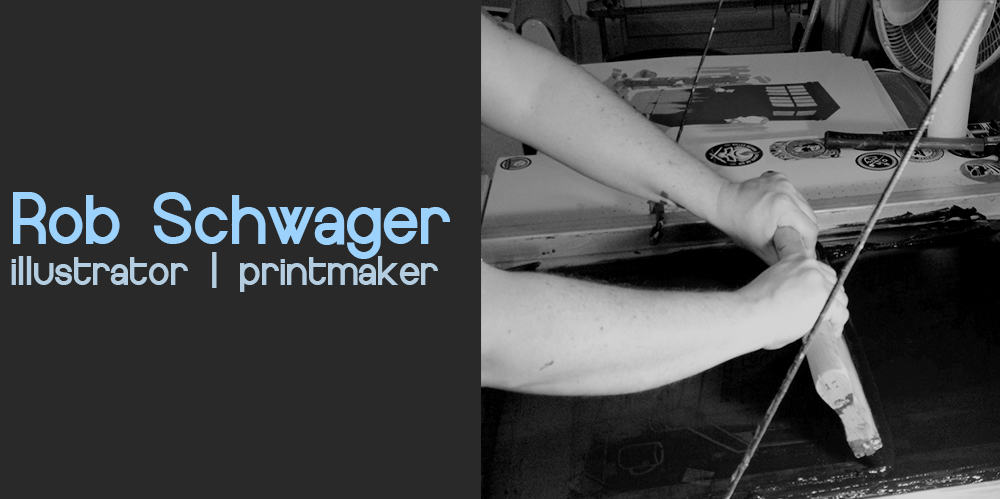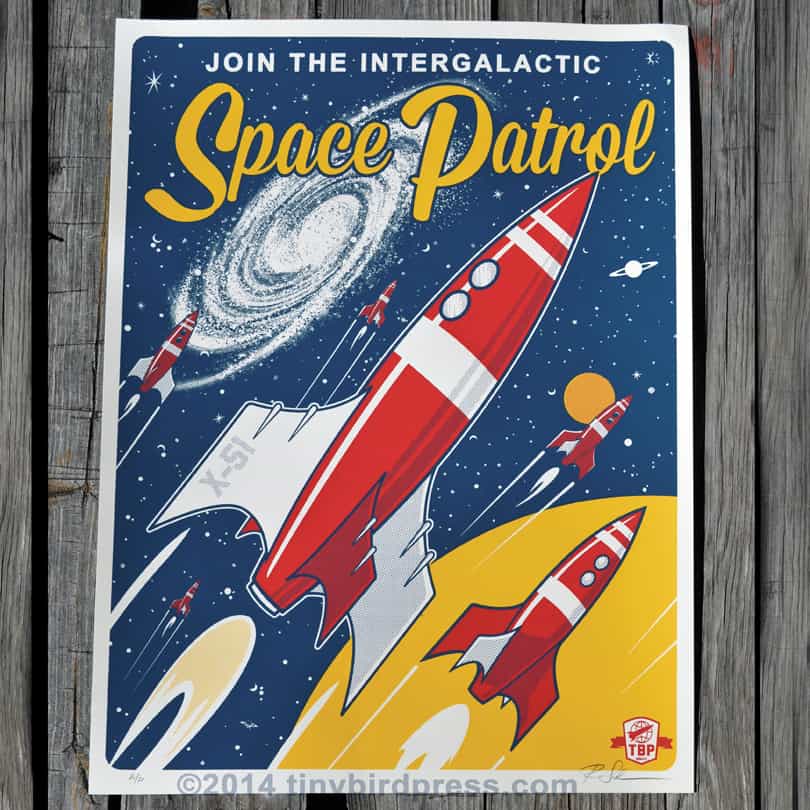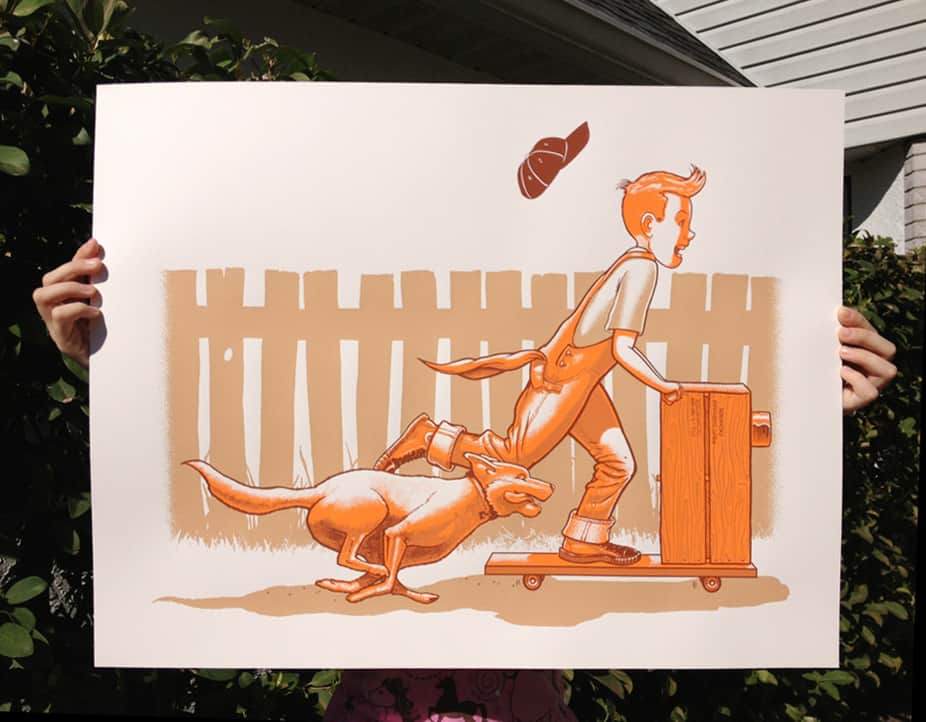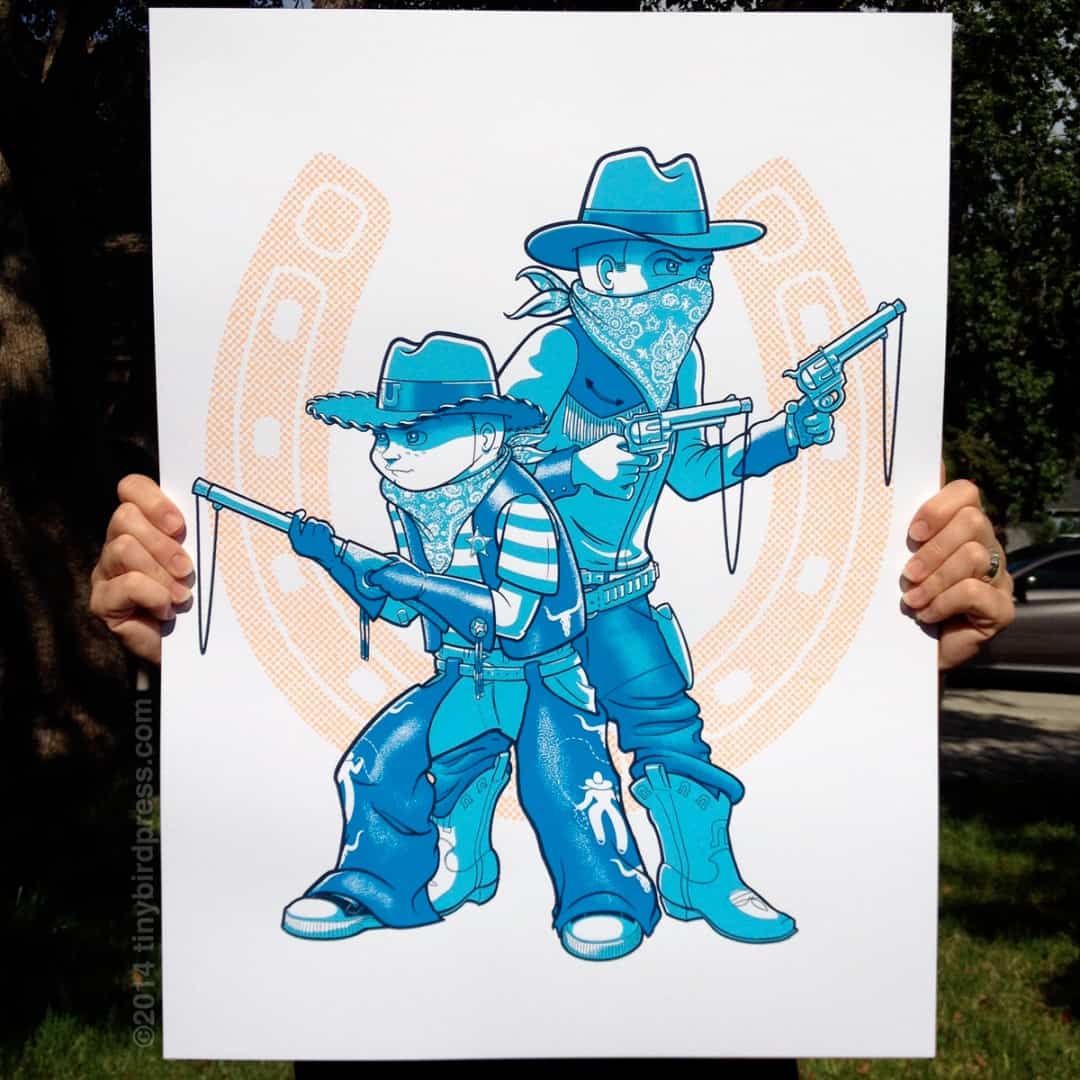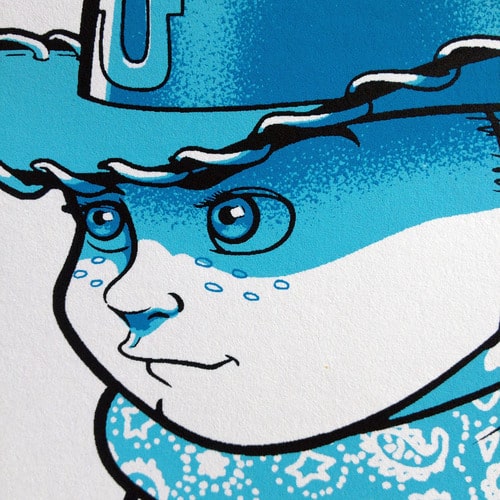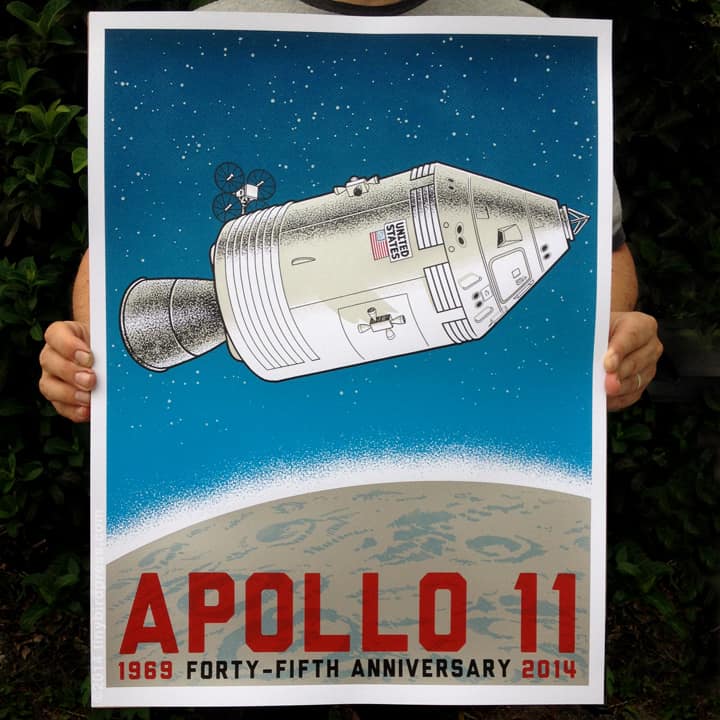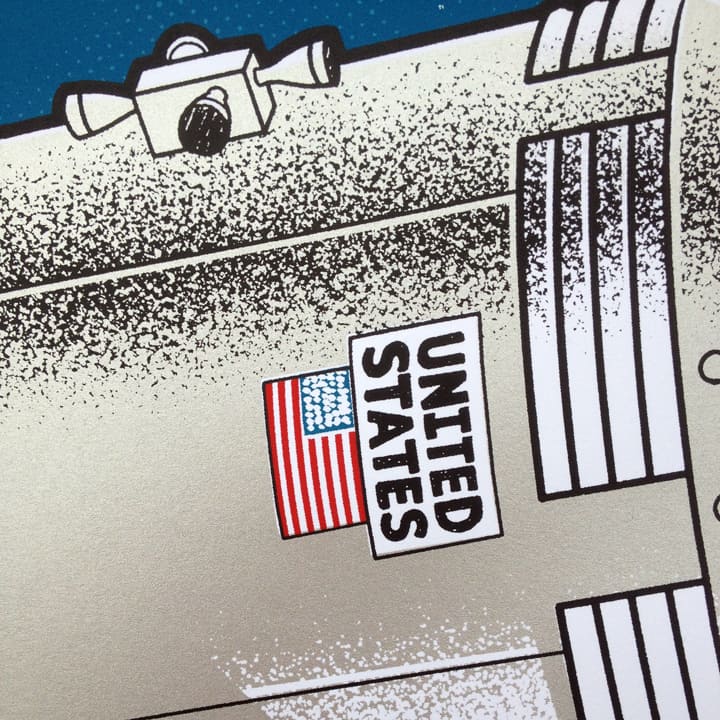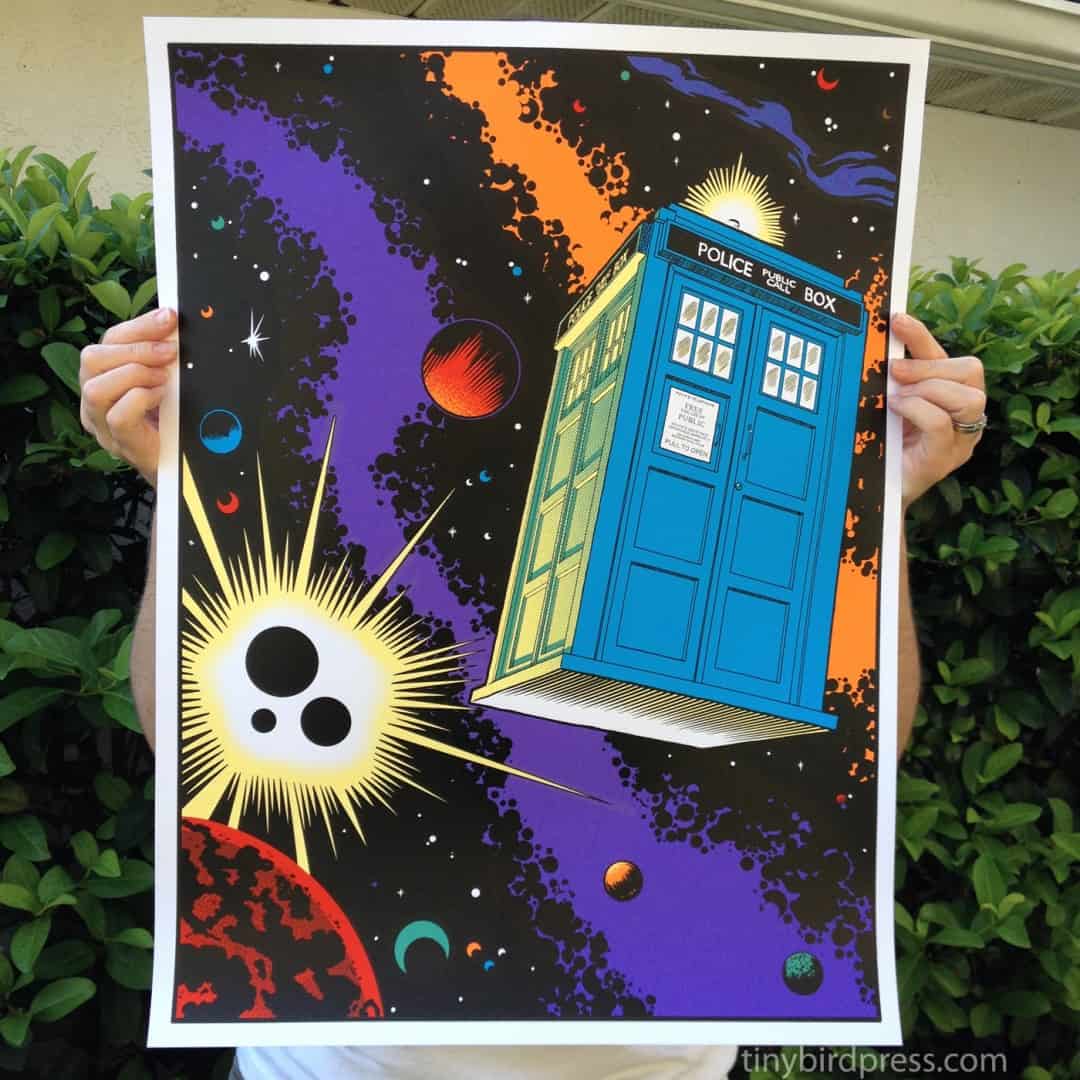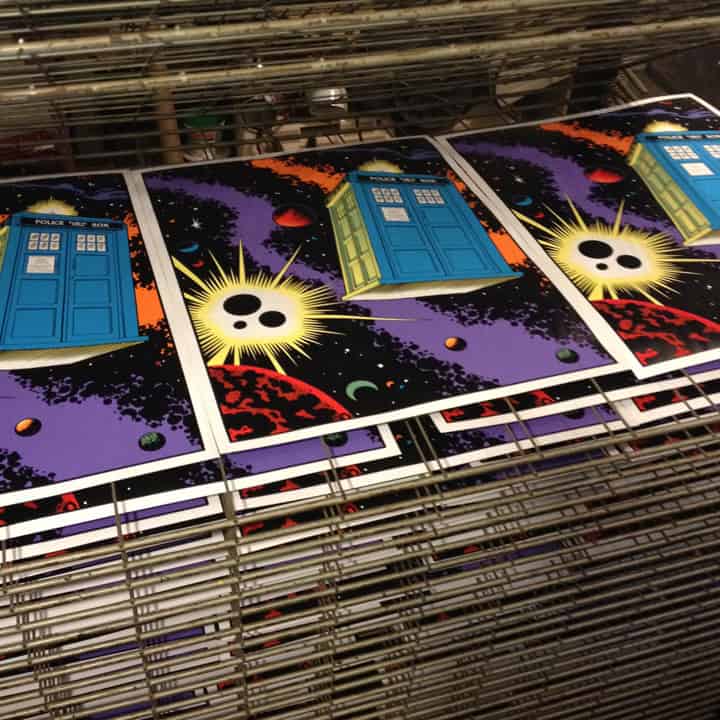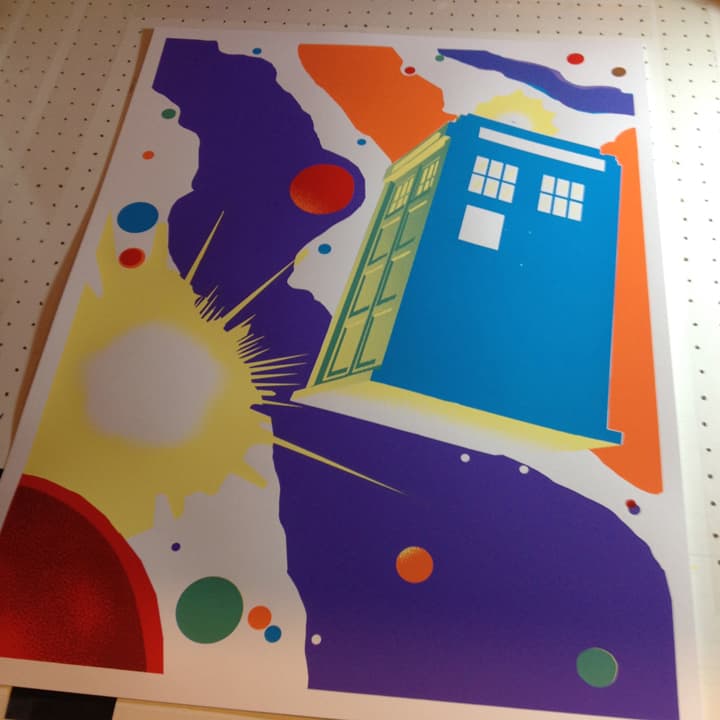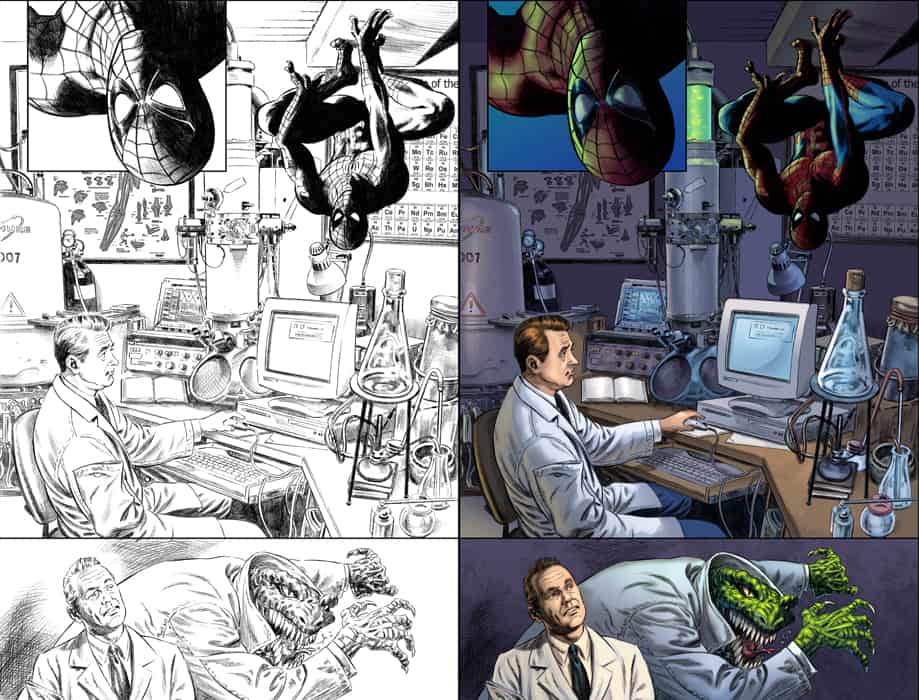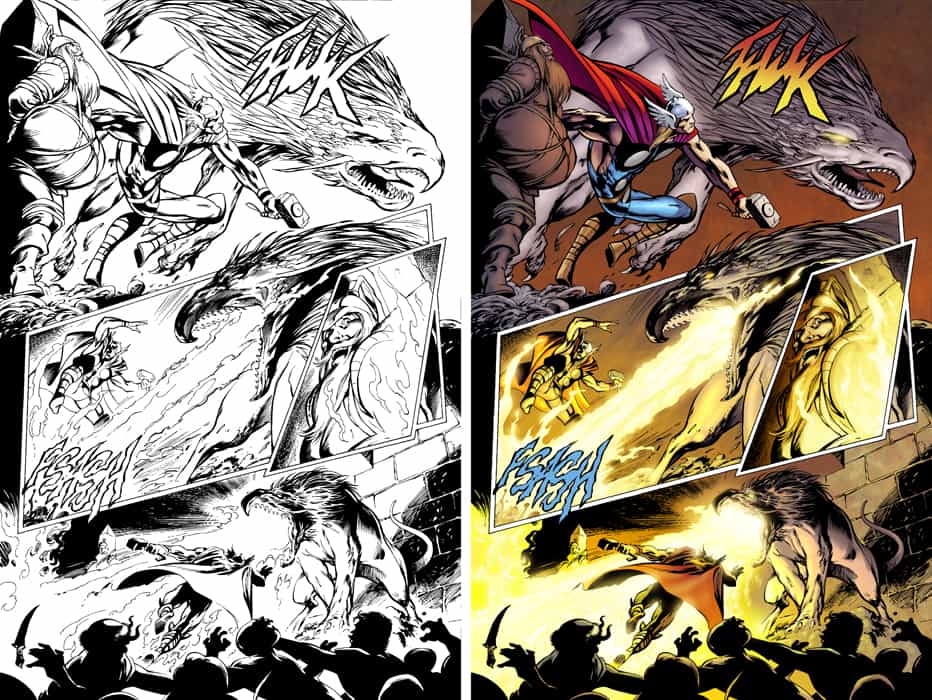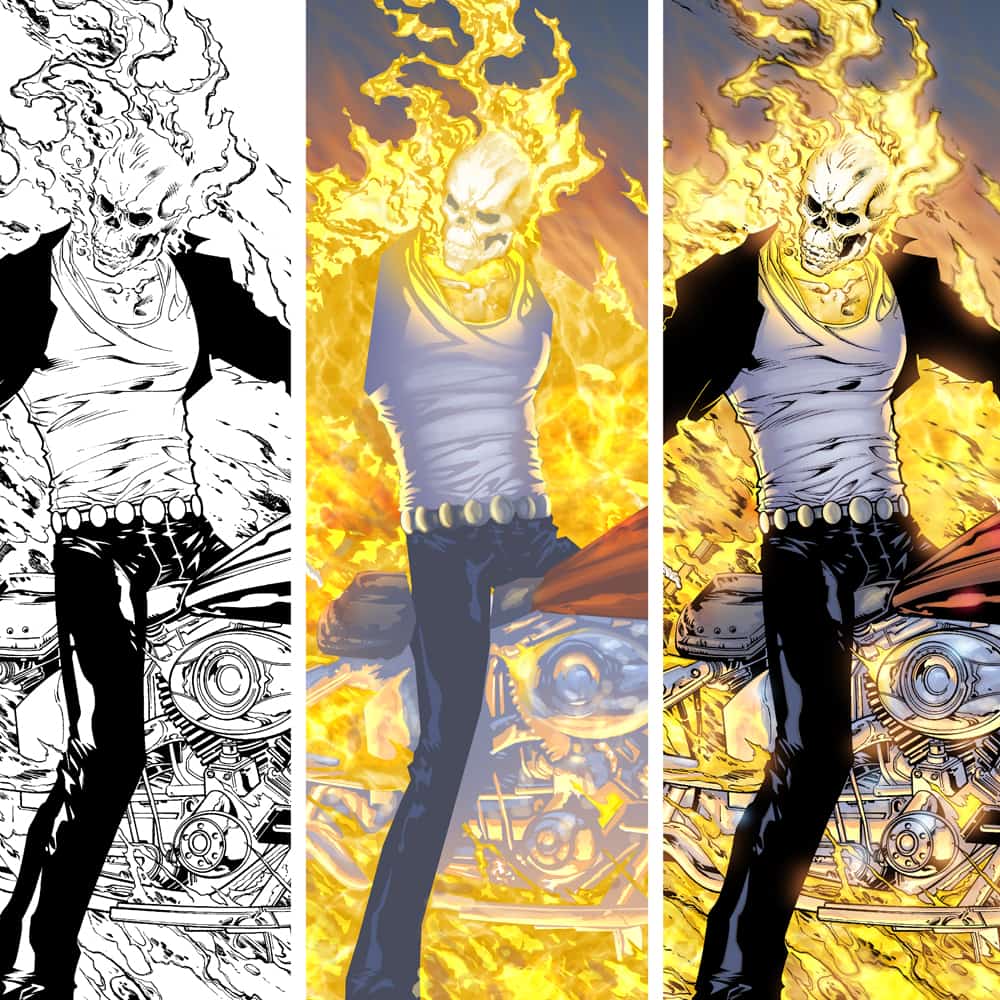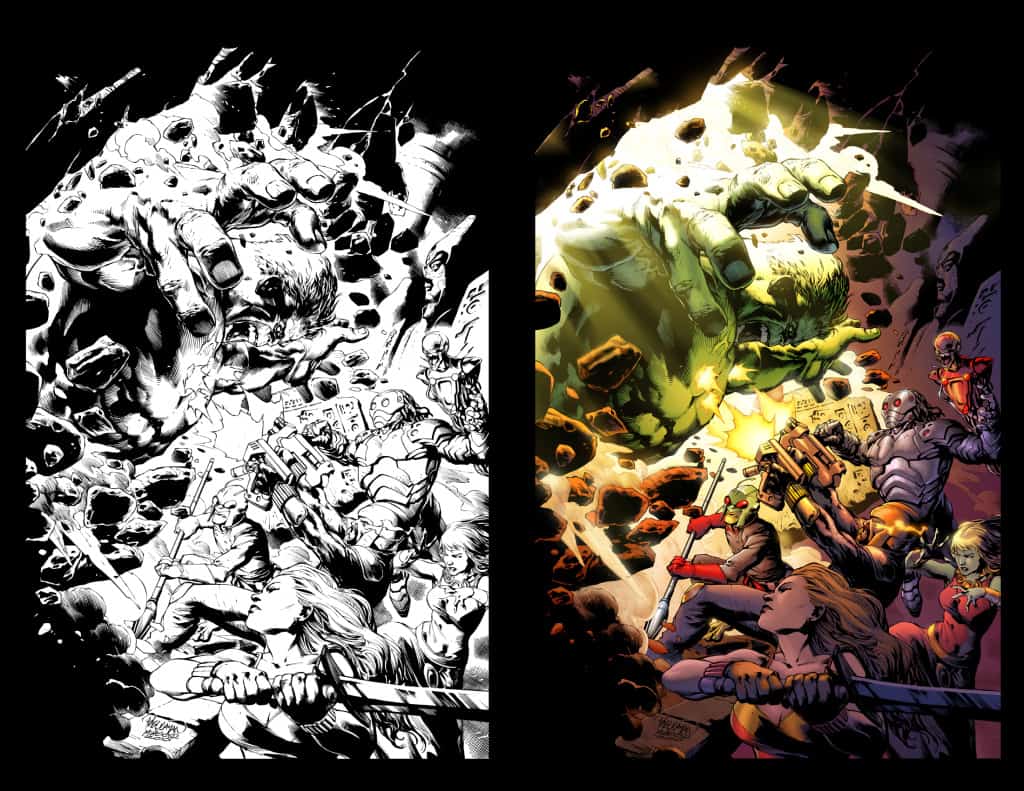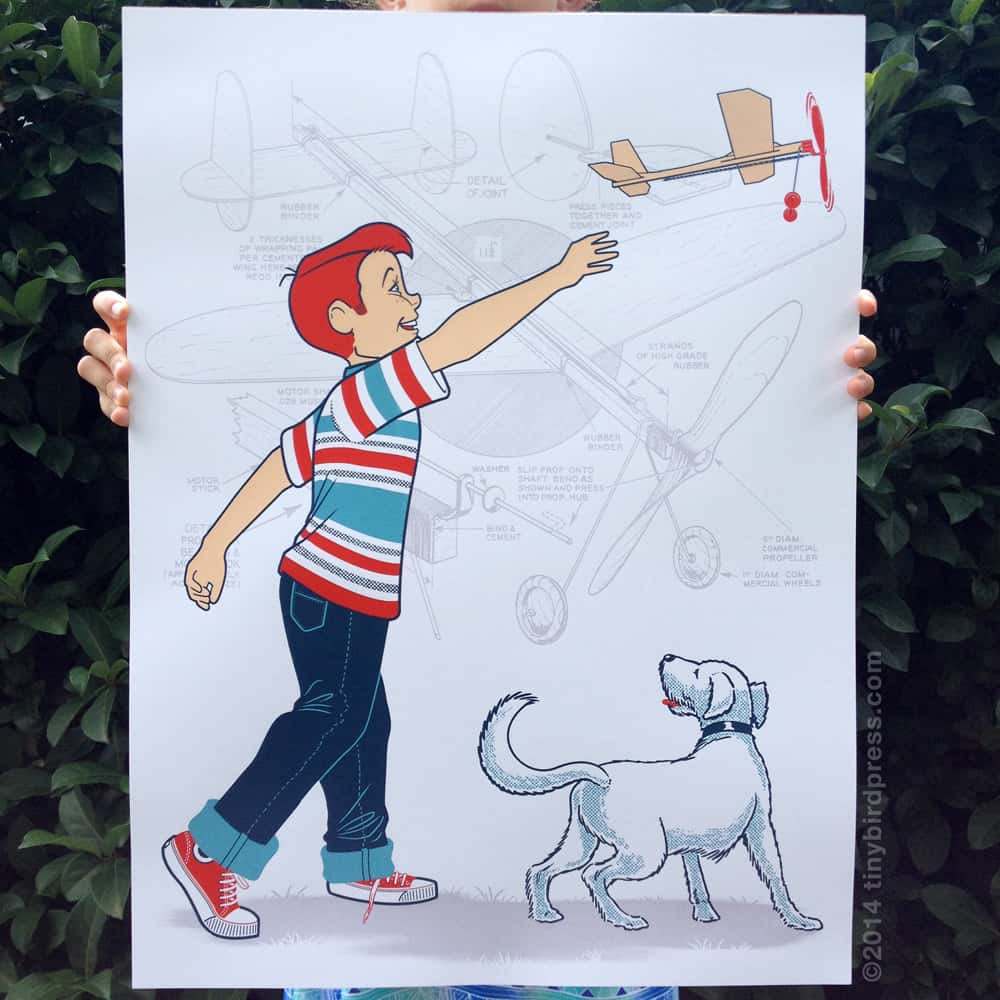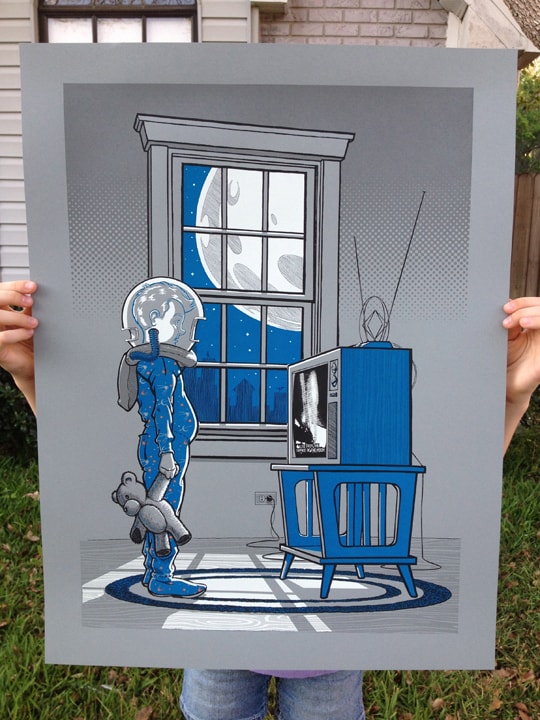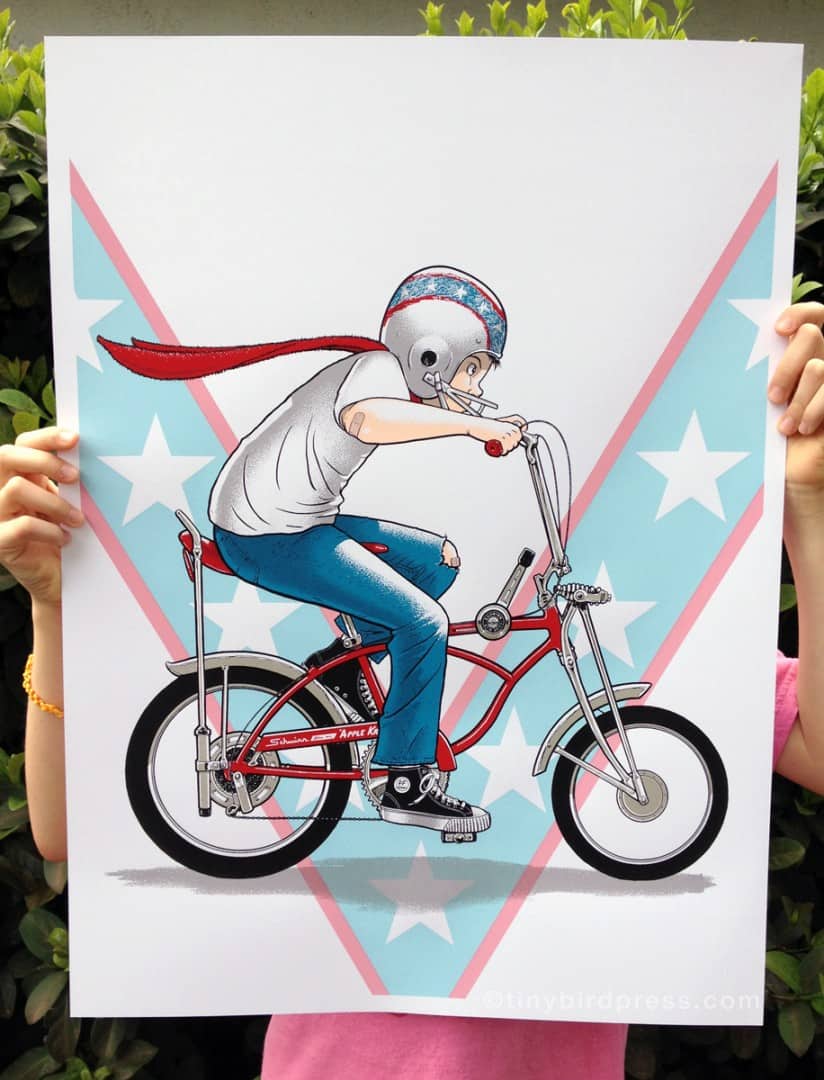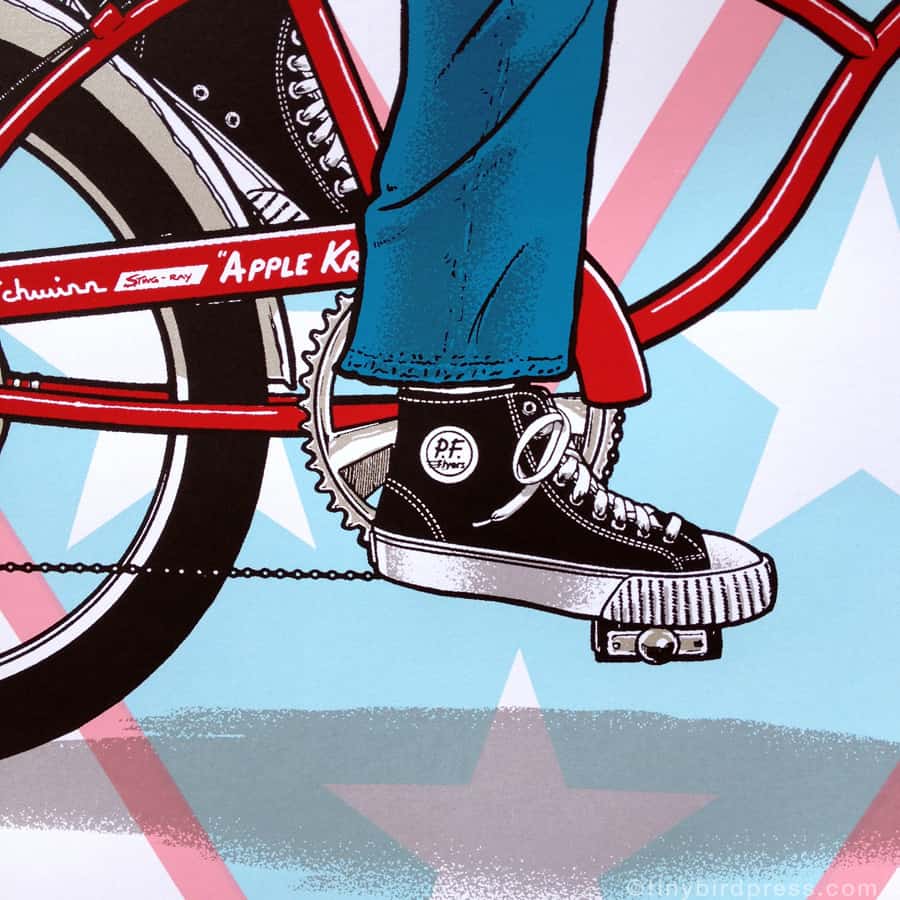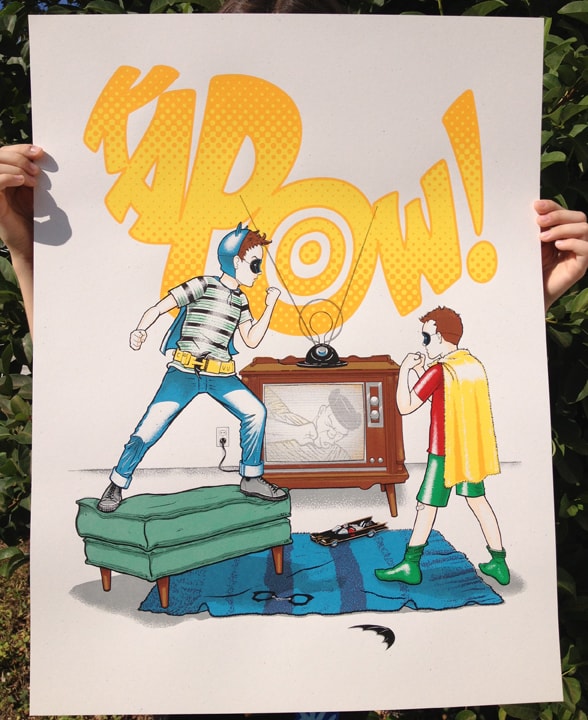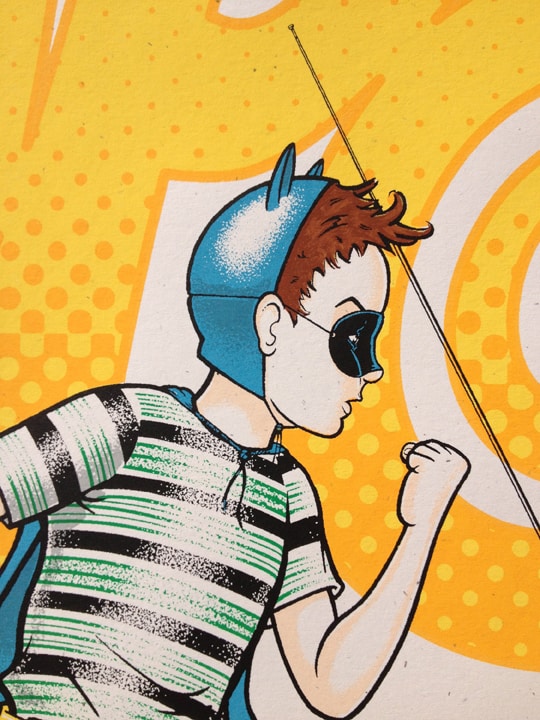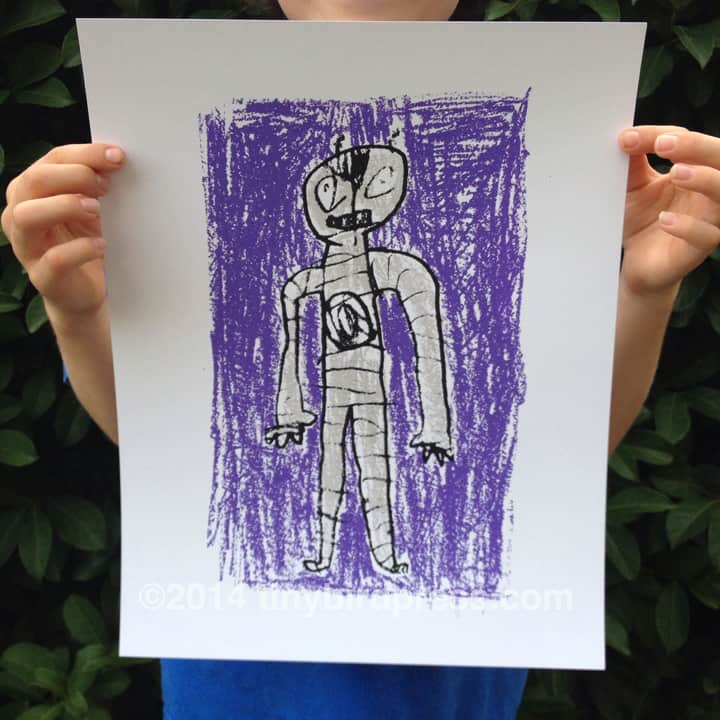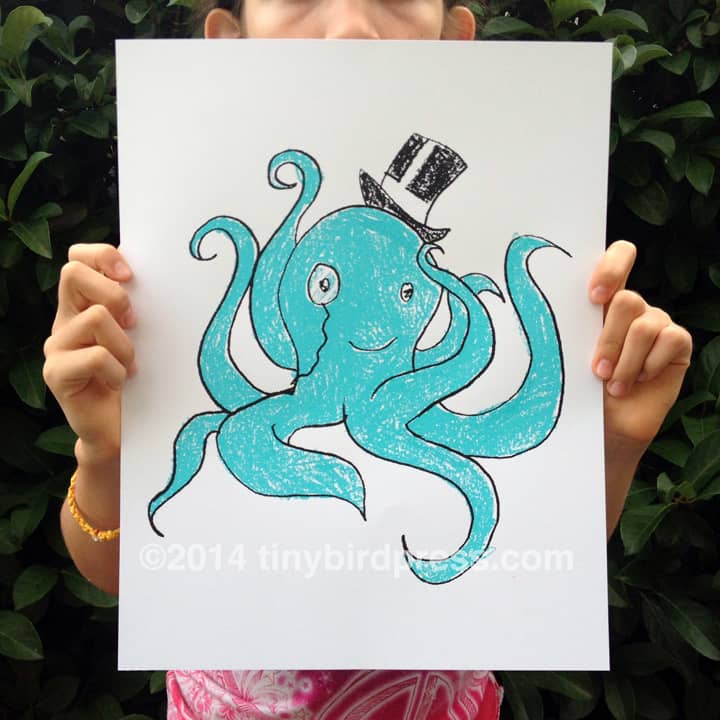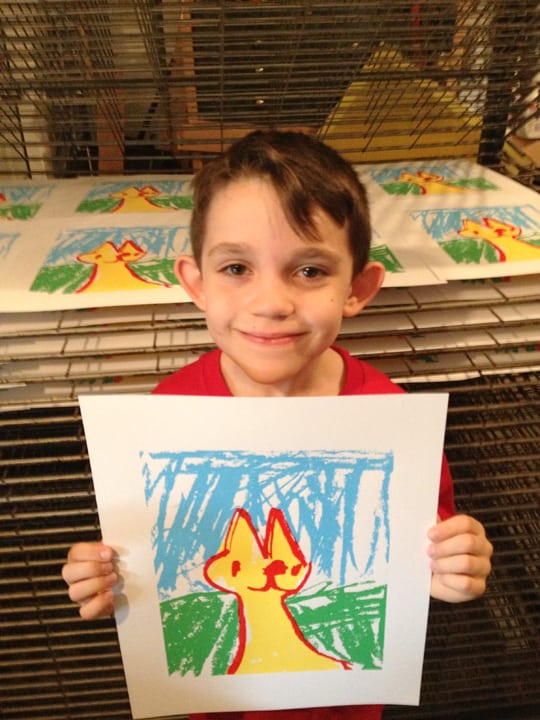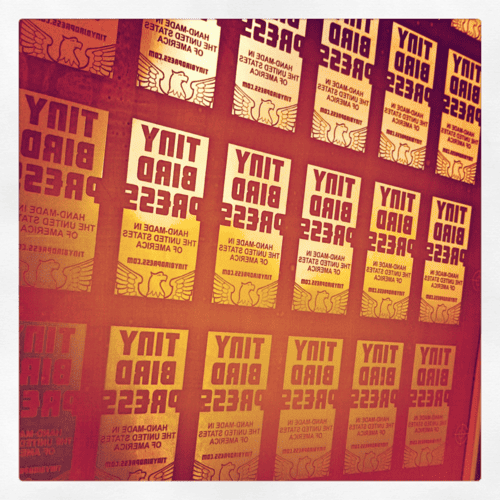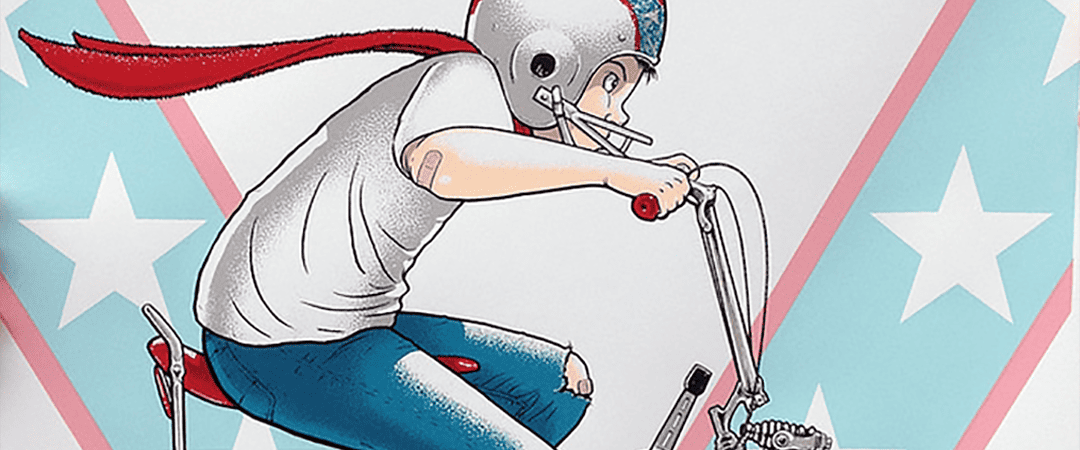
Rob Schwager is an artist, craftsman, father, and businessman — he’s a man who knows exactly how he wants to exist in the world and makes each role flow into the next. From the artisanal hand-pulled screenprints and store front of Tiny Bird Press to his career as a colorist in the comic industry, Schwager has used each experience to better himself in all areas of his life.
With his printmaking label Tiny Bird Press, Schwager takes a Norman Rockwell-like look not to his present, but to his past. The innocence and simple awe of childhood is a recurring motif, and with three children of his own, Schwager has inspired them to create their own run of limited edition prints.
His career is a lesson in hard work and dedication to craft and to family, and how it is possible for those elements to blend into something special.
______________________________________________________________________________________________________
ETDC: Your screen prints show a true love and admiration for vintage illustration styles. In that there’s nostalgia. Sentiment. Those interests come together in a piece like ‘Space Patrol,’ an affectionate depiction of an important moment in history. Your work is incredibly consistent – a real voice comes through. Do you see a separation between your work in the comic industry and your personal work as Tiny Bird Press?
RS: I feel there’s a HUGE separation. When I worked in the comic book industry, I was a freelancer, a hired gun. None of what I worked on belonged to me. My art with Tiny Bird Press, aside from the few pieces of fan art that I’ve done, is my own creation from concept to completion. It’s my own vision that I’m putting out in the world.
I call those nostalgia-based pieces, my ‘Childhood Americana’ work. It’s a theme that runs through most of my pieces. Reminiscing about my childhood. Taking time to reflect back on when life was all about playing and fun and the good times we had back then. I have lots of ideas for pieces that I would love to do, but sadly right now, I don’t have the time.
There’s a great warmth to your ‘Childhood Nostalgia’ series, the prints feel personal. Any plans for a series based on your experiences as a father? Looking at your kids’ childhood? Any other areas you’re looking to explore?
I don’t really have anything planned on my experiences as a father. However, I will say that occasionally some of my ideas for my prints are sparked from things that my kids do.
Things that for a lack of a better word ‘unlock’ long forgotten memories of fun stuff that I did as a child.
Case in point, the initial idea for ‘Popgun Showdown’ was sparked by my two boys playing in grandma’s backyard one time when we were on vacation. It was an idea that lived in my sketchbook for a while before I decided to release it.
Space exploration plays a big part of your work. ‘Space Patrol’ and ‘Moonshot’ shows that theme in the terms of our semi-current reality, as where your Dr. Who piece ‘Time and Space’ enters the Dr. Who world with comic book fantasy.
Even ‘Ready for Take-Off!’ has that sense of space exploration, albeit on smaller scale. Heck, even ‘Radio Drama’ takes on space on more frightening terms. What keeps you coming back that theme?
I was obsessed with space and science fiction as a child. The thought of possibly getting to explore outer space and meet creatures that I’d see in the sci-fi movies, consumed me.
Obviously, now that I’m grown up, I realize that things didn’t work out like I had planned. So, I try to recapture that sense of awe, wonder and excitement that I held so dear as a child, in my work. It takes me back to a happy place.
A bulk of your career has been spent as a colorist for Marvel, DC, Image, and others with some incredible titles under your belt. Were comics always your main focus, career-wise?
Not at all. I’d always read and loved comics as a kid, but I fell into working in the comic industry, purely by accident. Like most kids, I was always drawing and making stuff. I happened to have an aptitude for it.
When I was young, I had wanted to be a movie special effects guy. I totally LOVED the work of Ray Harryhausen, and ’new school’ (back then) guys like John Dykstra. I read magazines like Starlog obsessively. I bugged my parents for a Super 8 camera so I could do my own stop motion movies, but we couldn’t afford one.
Later, I got interested in wanting to do movie make-up. Think of guys like Dick Smith and Rick Baker, or modern TV shows, like ‘Face-Off.’ I thought that stuff was amazing. I’d make scar tissue out of silly putty, put it on my friends, paint it, and then we’d go down to the local mom and pop store to try and freak out the cash register lady while we bought candy.
I always wanted to do something creative, but my parents kept trying to guide me down the career path of doing something ‘sensible,’ like be a heating and cooling guy, or a plumber, etc., — some sort of trade that everybody could use. Completely safe and logical thinking on my parent’s part, but completely boring as far as I was concerned.
I wanted to ‘make stuff.’ I was repeatedly told ‘artists starve’ so, I worked a lot of crap warehouse jobs, all the while dreaming of doing something MORE with the talents I’d been blessed with. Eventually, one of the jobs I acquired was that of an apprentice cabinetmaker. I was building the interiors of high scale hotels and restaurants in places all over the U.S. Yeah, it was somewhat creative, as I was working with my hands, but still kinda boring.
After the shop I worked for closed, (because Donald Trump stiffed us after we built his Taj Mahal Casino in Atlantic City), I got a job at my favorite nightclub in Chicago. There a co-worker asked me if I wanted to make some extra cash coloring comic books on the computer. He knew I was artistic and liked comics, so I said sure. For a short while I had thought about trying to break into comics as an inker, but my hands were too shaky and I had no idea what I was doing.
Fast-forward 25 years later and I was still coloring comics. The only reason I stopped is because the industry was unable to continue to support guys like me. Sure, Marvel and DC are putting out blockbuster multi-million dollar grossing movies, but that stuff doesn’t trickle down to us guys doing the grunt work on the books that made those movies possible.
I rarely do comic work anymore. It was tough walking away from an industry I devoted such a huge chunk of my life to, but my family and my sanity are worth it.
What sort of work are you doing these days? Did you have an exit plan from comics?
I’m the senior graphic designer at one of the top supply companies in the tattoo industry. I’m surrounded by awesome art and artists, every day.
I didn’t really have an ‘official’ exit strategy when it came to leaving comics, aside from bills being due and we needed to pay them. Like I said, walking away from that career was tough, but it had to be done.
When you were working as a colorist, were you working from any sort or notes or direction from the editor or writer?
I’d usually request a copy of the script, which would hopefully have all the pertinent color and setting notes in it.
If there’s a pre-existing character, if the editor was worth his salt, they’d send me reference. Nowadays, they’d just tell you to Google the character.
It’s interesting to look at the black and white drawings compared to your finished colored versions – so much depth and life can be given to a drawing with a well-planned color palette and use of texture.
In comics, so much is going on, so many little details in a giant scene, yet you’re able to guide the viewer’s eye through the chaos. Did you do any color roughs before you got to work? After so long at it, did the work get automatic?
Nope, no color roughs. I’d basically open up the page, turn on the TV or a podcast to distract me, and then just start coloring.
I needed distractions to get through the pages, because if I thought too much about it, I could noodle a page to death for hours and hours.
Did all those years coloring comics have an affect on your own personal style? Was your drawing style pretty established before you went into comics? Would something like ‘Ready For Take-Off!’ look different had you not spent a good chunk of time as a colorist?
Most likely, yes. It would have looked much different. Working in the comic industry for as long as I did, and working with as many incredible artists as I have, gave me a deep appreciation for line values, and the economy of line work.
Looking at your ‘One Small Step’ print, you work at a much a smaller, more focused scale and it’s the use of color that really hits me. The light from the moon through the window is such a beautiful touch, subtle and powerful. It resonated with a lot of folks and you decided to do a second edition rather than leave the fans at the mercy of the prices on eBay.
Was that a tough decision to make, to decide on a second pressing? How true to the first edition did you try to be? Do you want a slight variation between the two?
It was very a difficult decision for me. I debated it for a looong time. Not a week would go by where folks would be e-mailing me asking me to reprint that one, and my first one TBP release, ‘Remember When.’
I see both sides of the argument. There’s my side, ‘It’s MY art and I can do what I want with it, so if that means re-printing it or licensing it a billion times over, it’s MY art, so deal with it.’ And the, ‘we’re collectors and if you re-print it, it ‘cheapens’ the original release,’ side as well.
I got tired of hearing about folks shelling out big cash for the print. So I decided to do a second edition. There was a slight color variation with the blue, and I made all of them glow-in-the-dark instead of just a few but otherwise, it was pretty much the same. I have no plans to do a third edition.
When did the screen-printing start? How much time are you able to dedicate to Tiny Bird Press?
It started back in the mid 90’s. I used to be a bouncer at a nightclub/concert venue in Chicago. I would see all these colorful Frank Kozik gig posters come in, advertising various shows. I thought to myself, ‘I can do THAT,’ so I researched what type of process it was, and I eventually made a few gig posters myself.
Then I talked my way into an art director’s job at a local screen-printing shop. The owner was a fan of art prints and gig posters, so he let me go nuts in the shop after all the day’s work was done. Eventually, I quit doing gig posters and hadn’t done any for many years. I got tired of dealing with idiotic promoters and greedy band management. I also stopped screen-printing altogether for over a decade. I started getting the desire to do it again a few years back, so I started Tiny Bird Press.
When I was freelancing, I was able to devote tons of extra time to Tiny Bird. See, I set up my print ‘studio’ in my garage at home. When I would be done coloring comic stuff, I could walk out there and just start printing. Now that I have a 9-5 job, I print in the wee hours before work, and then after I get home from my 10-hour day (including my commute), and also on weekends.
You don’t attend any comic conventions, but you used to. What changed? Are you doing any poster events with Tiny Bird Press?
A bunch things…like the fact that the conventions stopped being about comics and now are just places where Hollywood goes to mine the latest undiscovered intellectual property. I’d go to cons to hang with friends and editors I’d see once or twice a year. Not to mention the fact that after my kids were born, I didn’t really want to be away from them, and taking the whole crew wasn’t an option.
Also, I’ve never really been that much of a ‘people-person.’ As I’ve gotten older, I’ve become more introverted and increasingly uncomfortable in large crowds.
As far as going to poster events, I went to the very first Flatstock. I was still doing concert posters back then. I haven’t been back to one since, basically because I don’t do concert posters anymore. I’d like to possibly start doing small art fairs or hand-made craft type shows, like Renegade, but nothing is set in stone.
Having a daughter myself, one of the coolest things I’ve seen in a long time is the work you do with your kids. They both create and sell their own prints, a total family that plays together thing. As a new dad I have to ask – was their interest a natural thing, or did you have to do a little pushing?
Well, my 3 kids are SO amazingly creative. They’re constantly drawing and making things. It blows my mind sometimes when they show me the stuff they’ve created. My wife and I try to nurture that as much as possible. Then one day my daughter asked me if she could do an art print too. So, it came about as a way to spend more quality time together.
After I quit doing comics and got a ‘9-5,’ with a long commute each way, I’m gone ten hours a day. In the past I was around them all the time. Now, weekends and evenings are pretty much it. And as we all know, most people’s weekends are filled with doing stuff we aren’t able to get done during the week.
I also made a conscious decision to use only water-based inks, because I knew my kids would be around this stuff and I didn’t want them breathing in all the toxic fumes from solvent based inks. We have a blast printing, and I just love the expression on their faces when we tell them they actually sold some work.
I’m trying to teach them that hard work also pays off. As well as teaching them a trade and how commerce works. My daughter LOVES to draw little ‘thank you’ pics on the packing slips. My boys have started doing it too. So in effect, folks are getting a print AND an original when they buy stuff from my kids.
Do you guide them through what would work best as a screen-print and what is better off an original work? How involved are you helping out with something like your son’s awesome ‘Yellow Cat’ print?
My son’s yellow cat print was pretty much all him. My kids doodle constantly. I’ll come home from work and there’s always copious amounts of papers strewn about the house with new things to look at on them. My role in their work is finding those tiny gems on some of those pages and not letting them get lost forever.
I’ll guide them when it comes to doing stuff like color separations, prepping the screens, and getting everything actually ready to go to print. The ‘process’ or production end of making the prints. Occasionally I’ll recommend ink choices, like suggesting metallic silver for my son’s robot print, but the base art, is basically ALL them.
In the end, the final product is a total collaborative effort. I get to pass on what I know to them. As they get older, I’m hoping they’ll eventually get to a point where they can just start printing things on their own, without me having to oversee everything. Either way, I love spending time with them and I hope my kids and I can work together creating lots of cool things for many more years to come.
With having kids, how do you split your time between comics, Tiny Bird Press, and family? Do you keep a strict work routine?
Not really. I just don’t sleep a lot and I love to work. Plus, we’re a one income family, so daddy has gotta hustle!
For more of Rob Schwager’s work check out these handy links —
Rob Schwager’s Page on Comic Book Resources Dot Com
